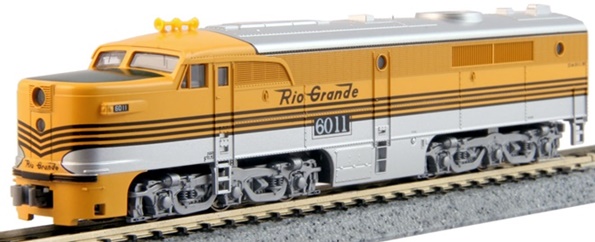



Introduced: 1998 (revised in 2005 and 2008, DCC-equipped in 2018, DCC-Sound in 2019)
These models have a chassis / mechanism very much similar to Kato's 1993 E8 (albeit a bit shorter). And do not confuse them with the PA/PBs Kato made for Con-Cor starting in the 1960s - totally different animals all-together.

The mechanism is absolutely state of the art - DCC-Ready metal chassis, 5-pole motor, dual flywheels, all-wheel drive and pickup, low-friction current collection, directional LED lighting, low-profile / blackened wheels, etc. Except for the lightboard (no LED on the "B" unit) the "A" and "B" units share an identical chassis/mechanism. Mine (pictured above) has a Digitrax decoder installed in place of the stock lightboard.
These models originally came with knuckle (as opposed to Rapido-style) couplers. Apparently Kato's philosophy (at the time) was that Freight=Rapido and Passenger=Knuckle. And since these models were released with passenger service in mind, Kato decided to equip them with knuckle couplers. The couplers on the first runs were only semi-operational (they would couple automatically, but not uncouple). Later runs would come with Kato's proprietary automatic (magnetic) couplers. The first-run knuckle couplers can be converted to Micro-Trains, although I found said conversion to be a difficult one.
These engines perform breathtakingly smoothly and quietly at all speeds. The hefty chassis makes for superior pulling power. And these models might just have the most amazingly affective flywheels I've ever seen - drop down from full throttle and these will coast damned near two feet before slowly gliding to a stop. The shells are gorgeous, with fine paint and detailing. I guess my only nitpick is that the rear couplers on the "A" units (and both couplers on the "B" units) are truck-mounted rather than shell-mounted. But, that's a minor quibble.
These models were re-run in 2005 (ATSF, DH, DRGW) and, as mentioned previously, came with Kato's new automatic/magnetic couplers.
Another run came out in 2008, the major change being printed and lit numberboards (the plastic assembly that mounts inside the shell had numberboards added to it, and a couple of holes were made in the shell for said numberboards to stick through).
The 2018 production run was the first to include factory-installed DCC (Train Control Systems K0D8 series DCC decoders). DCC-Sound versions with factory-installed ESU LokSound decoders were released in 2019.
To remove the shell, simply spread the sides apart and lift.
Grade: A
Reviewed: 8/98 Model Railroader, 9/98 Model Railroader ("The latest additions to Kato's growing line of fine N scale locomotives are Alco PA-1 and PB-1 passenger diesels. These models, made in Japan, are finely detailed and run as well as they look... Kato offers the locomotive in several versions. All the railroads for which Kato is painting the model had dynamic brakes, represented on the model's roof. Kato offers the PA with single or dual headlights and either small side number boxes or large angled number boxes, depending on the prototype. For railroads that owned B units, the B unit is sold as part of an A-B set. For railroads that didn't own B units, two A units are packaged in a set, each with different numbers. Single A units are available for all road names, and NYC, PRR, SF, SP, and UP fans can chose from two different A-B sets, which when combined with the single A unit, make a total of 5 distinct road numbers for those railroads... The model closely matches the PA-1 prototype drawings... The shell is exquisite, with nice suggestions of depth in many locations. This is especially evident in the grillwork on the sides of the locomotive and the roof details. Even the blades are clearly visible in the roof fan. The truck sideframes are also well defined with details standing out in relief... The flange depth and gauge checked out against the NMRA standards gauge... The weight and motor take up all available space inside the shell, but Digitrax makes a DCC decoder (DN145K) mounted on a replacement circuit board... I was quite impressed with the sharpness of the lettering and overall quality of the finish... The lack of factory-applied lettering in the number boards is a glaring omission on an otherwise fine locomotive. It's especially noticeable on locomotives with the large number boxes. Performance is pretty much in line with what we've come to expect from Kato - in other words, flawless. The model ran well right out of the box and displayed an incredible range of speeds. The PA has the same powerful 5-pole skew-wound motor found in the firm's E8 from a few years ago. The motor, combined with all-wheel pickup, means contact is constant and reliable... Where the locomotive really excels is out on the line. A single unit has a 1.4-ounce drawbar pull, which translates to about 19 N scale passenger cars... Head-to-head comparisons among Life-Like's PA, Kato's model, and the earlier Con-Cor PA are inevitable. While both Life-Like and Con-Cor come in lower than Kato on price, and Life-Like gets a nod for having numbers in their number boards, the Kato model is the quietest, smoothest-running N scale diesel I've encountered. Although Life-Like's PA can outpull the Kato model (BULL! -Mark), the finer shell detail means I'd have to give Kato the nod as the all-around "best" N scale PA-1 offered to date. With its beefy, read-for-action looks and well-done classic paint schemes, Kato has a hands-down winner with the PA-1 and PB-1. AT&SF, EL, NYC, PRR, SP, UP, Wabash, Undec. Price: $91.98 ($183.96 for A-A or A-B set)")